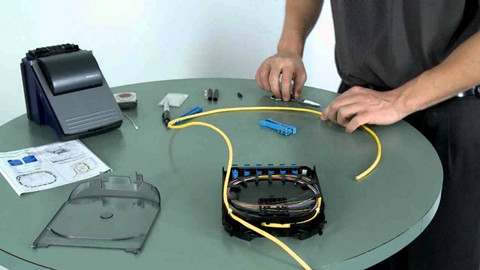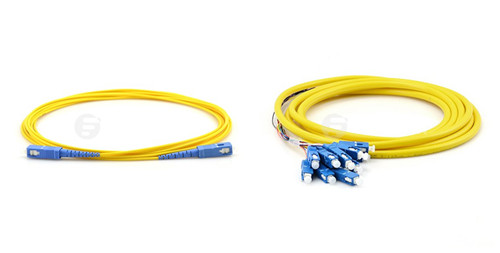A smooth connection between cable and other optical devices allows the optical signals to pass with low attenuation and little return loss, which is vital for telecommunication network. Fiber optic pigtails, compared with the regular fiber jumper, is terminated with fiber optic connector at only one side of the cable, which are usually used with fiber optic management equipment like ODF, splice closures and cross cabinets. Today’s article will provide some detailed information about fiber optic pigtails.
What Is Fiber Optic Pigtail?
Fiber optic pigtail is also called bare fiber. It is a kind of optical cable terminated with fiber optic connectors at one side of the cable while leave the other side no connectors, so that the connector side can link to the equipment (eg. fiber converter or optical transceiver module) and the other side can be melted with optical fiber. In fact, fiber optic pigtail and patch cord are similar in structure, fiber optic patch cable is composed of a fiber optic cable terminated with connectors on both ends. Sometimes, we cut the fiber optic patch cord in the middle, strip its jacket and then end up with a pigtail. Figure 1 shows the process of fiber optic pigtail splicing.

Fiber optic pigtails are designed to meet or exceed all of the performance requirements for current and proposed applications. They are available in various optical connector type, single-mode and multimode fiber, as well as fiber counts and cable structure. Here is what you need to know about the classification of fiber optic pigtails.
Divided by the Optical Connectors
Commonly used fiber optic pigtails are available in SC, FC, LC, ST, MU, E2000 and MTRJ type.
LC Fiber Optic Pigtails: LC features the low cost and high precision 1.25mm outer diameter ceramic ferrules and highly favored for single mode applications. LC fiber optic pigtail use LC connector and suit for density installations.
SC Fiber Optic Pigtails: SC connector is a non-optical disconnect connector with a 2.5mm pre-radiused zirconia or stainless alloy ferrule. It is light weight and economic to use in different applications such as CATV, LAN, WAN, test and measurement. SC fiber optic pigtails are also a commonly used pigtail type in cable installation. The following picture shows a SC fiber cable (left) and SC fiber optic pigtail (right) .

ST Fiber Optic Pigtails: ST fiber optic connector is the most popular connector for multimode fiber optic LAN applications. It has a long 2.5mm diameter ferrule made of ceramic (zirconia), stainless alloy or plastic. SC fiber optic pigtails are used in telecommunications, industry, medical and sensor fields.
FC Fiber Optic Pigtails: FC fiber optic pigtails use the metallic body FC fiber optic connectors. FC features the screw type structure and high precision ceramic ferrules. FC fiber optic pigtails and related products are known for the general and average applications.
MU Fiber Optic Pigtails: MU connector is called “mini SC” as it is only half size of the SC and are more popular in Japan. Applications of MU connectors include high-speed data communications, voice networks, telecommunications, and dense wavelength division multiplexing (DWDM). MU fiber optic pigtails use the MU connector that inherits the features and advantages of SC connector.
MT-RJ Fiber Optic Pigtails: MT-RJ fiber optic pigtails use the MT-RJ connectors that are specially designed for fast Ethernet. They are all duplex types with a mini ribbon fiber inside. MT-RJ inherit the features from the MT connectors and RJ45 connectors, as its name “MT-RJ”. MT-RJ optical fiber pigtails are small form connector products that fit for density applications.
E2000 Fiber Optic Pigtails: E2000 connector features a spring-loaded shutter which fully protects the ferrule from dust and scratches. With 1.25mm ferrule, snap-in mechanism, it is available in single mode and multimode. E2000 fiber optic pigtails also have a wide range of applications.
Single-mode and Multimode Fiber Optic Pigtails
Just as fiber optic patch cords, fiber optic pigtails can also be designed in multimode and single-mode fiber. Multimode fiber optic pigtails use 62.5/125 micron or 50/125 micron bulk multimode fiber cable and terminated with multimode fiber optic connector at one end. General multimode fiber optic cable jacket color is usually orange. In addition, 10G multimode fiber cables (OM3 or OM4) are also available in fiber optic pigtails. The jacket color of 10G OM3 and OM4 fiber optic pigtail is usually aqua.
Conclusion
Fiber optic pigtail can be fusion spliced onto a pre-terminated fiber optic cable assembly to extend the cable distance or onto field-terminated cables to provide the connectorized end. As noted before, fiber optic pigtail can be categorized by different standard. According to the cable jacket materials, there are PVC/LSZH fiber optic pigtail, armored fiber optic pigtail and waterproof fiber optic pigtail, etc. Fiberstore provides a wide range of fiber optic pigtails, including 9/125 single-mode, 62.5/125 multimode, 50/125 multimode and 10G 50/125µm OM3 types, simplex fiber, 4 fibers, 6 fibers, 8 fibers, 12 fibers, 24 fibers, 48 fibers and so on. These fiber pigtails can be with fan-out kits and fully compliant to Telcordia, EIA/TIA and IEC standards.
评论
发表评论